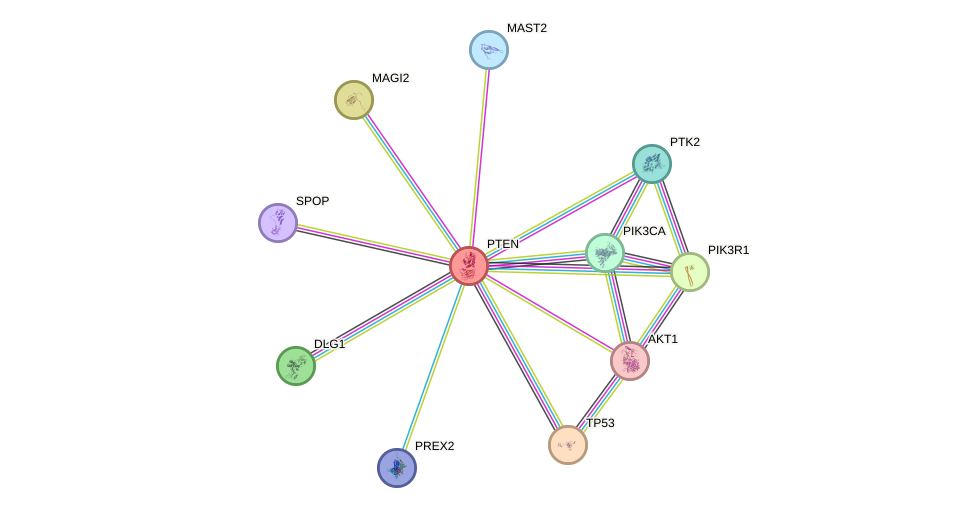GenAge entry for PTEN (Homo sapiens)
Gene name (HAGRID: 63)
- HGNC symbol
- PTEN
- Aliases
- MMAC1; TEP1; PTEN1; BZS; MHAM
- Common name
- phosphatase and tensin homolog
Potential relevance to the human ageing process
- Main reason for selection
- Entry selected based on evidence directly linking the gene product to ageing in a non-mammalian animal model
- Description
PTEN is a tumour suppressor involved in cell cycle progression as an inhibitor of insulin (INS) signalling. In roundworms, a PTEN homologue has been related to development and longevity regulation through the INS-like pathway [1348]. The same gene has been shown to mediate nutrient-dependent cell cycle arrest and growth in the germline of roundworms [1771]. PTEN-null mice die at embryonic stages while heterozygous animals develop tumours [1757]. In mice lacking PTEN in oocytes the entire primordial follicle pool becomes activated and thus all primordial follicles become depleted in early adulthood causing premature ovarian failure [1905]. Mice carrying additional copies of PTEN are protected from cancer and present a modest (16%) extension of life span that is independent of their lower cancer incidence [2457]. Mutations in the human PTEN gene have been associated with cancer [1577], and further studies are necessary to determine whether PTEN plays a role in human ageing.
Cytogenetic information
- Cytogenetic band
- 10q23.3
- Location
- 87,863,438 bp to 87,971,930 bp
- Orientation
- Plus strand
Protein information
- Gene Ontology
-
Process: GO:0000079; regulation of cyclin-dependent protein serine/threonine kinase activity
GO:0001525; angiogenesis
GO:0001933; negative regulation of protein phosphorylation
GO:0002902; regulation of B cell apoptotic process
GO:0006470; protein dephosphorylation
GO:0006661; phosphatidylinositol biosynthetic process
GO:0006915; apoptotic process
GO:0007270; neuron-neuron synaptic transmission
GO:0007416; synapse assembly
GO:0007417; central nervous system development
GO:0007507; heart development
And 82 more GO terms Cellular component: GO:0005576; extracellular region
GO:0005634; nucleus
GO:0005654; nucleoplasm
GO:0005737; cytoplasm
GO:0005739; mitochondrion
GO:0005829; cytosol
GO:0005886; plasma membrane
GO:0009898; cytoplasmic side of plasma membrane
GO:0016324; apical plasma membrane
GO:0016605; PML body
GO:0035749; myelin sheath adaxonal region
And 6 more GO terms
Show all GO termsFunction: GO:0000287; magnesium ion binding
GO:0004438; phosphatidylinositol-3-phosphatase activity
GO:0004721; phosphoprotein phosphatase activity
GO:0004722; protein serine/threonine phosphatase activity
GO:0004725; protein tyrosine phosphatase activity
GO:0005161; platelet-derived growth factor receptor binding
GO:0005515; protein binding
GO:0008138; protein tyrosine/serine/threonine phosphatase activity
GO:0008289; lipid binding
GO:0010997; anaphase-promoting complex binding
GO:0016314; phosphatidylinositol-3,4,5-trisphosphate 3-phosphatase activity
And 7 more GO terms
Protein interactions and network
- Protein-protein interacting partners in GenAge
- TP53, TXN, AKT1, PDGFRB, HSP90AA1, EGR1, UBE2I, EEF2, AR, PRDX1, HSPD1, HSPA1A, PTK2B, PTK2, BMI1, HSPA8, MXD1, ESR1, CTNNB1, PPP1CA, DBN1, STUB1, PDGFRA
- STRING interaction network
Retrieve sequences for PTEN
Homologs in model organisms
In other databases
- GenAge model organism genes
- CellAge
- This gene is present as PTEN

